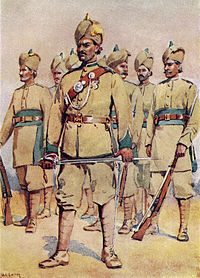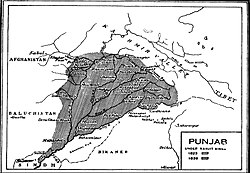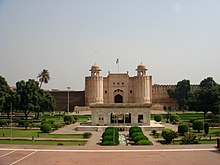History of Punjab.
British Raj.
Main article: Punjab Province (British India)
Punjab Province during the British Raj, also included the non Punjabi speaking regions, 1909
The 33rd Punjabi Army (A Picture of a Commander: A Punjabi Subadar).
As a condition of the peace treaty, some British troops, along with a resident political agent and other officials, were left in the Punjab to oversee the regency of Maharaja Dhalip Singh, a minor. The Sikh army was reduced greatly in size. In 1848, out-of-work Sikh troops in Multan revolted, and a British official was killed. Within a few months, the unrest had spread throughout the Punjab, and British troops once again invaded. The British prevailed in the Second Anglo-Sikh War, and under the Treaty of Lahore in 1849, the Punjab was annexed by the British East India Company, and Dhalip Singh was pensioned off. The Punjab became a province of British India, although a number of small states, most notably Patiala, retained local rulers who recognised British sovereignty.
In every way, the Punjab was one of Great Britain's most important assets in colonial India. Its political and geographic predominance gave Britain a base from which to project its power over more than 500 princely states that made up India. Lahore was a centre of learning and culture under British rule, and Rawalpindi became an important Army installation.
The Jallianwala Bagh Massacre of 1919 occurred in Amritsar. In 1930, the Indian National Congress proclaimed independence from Lahore. The 1940 Lahore Resolution of the Muslim League to work for Pakistan, made Punjab the centre-stage of a different, bloodier struggle.
In 1946, massive communal tensions and violence erupted between the majority Muslims of Punjab, and the Hindu and Sikh minorities. The Muslim League attacked the government of Unionist Punjabi Muslims, Sikh Akalis and the Congress, and led to its downfall. Unwilling to be cowed down, Sikhs and Hindus counter-attacked and the resulting bloodshed left the province in great disorder. Both Congress and League leaders agreed to partition Punjab upon religious lines, a precursor to the wider partition of the country.
The British Punjab province, which includes present-day Punjab province of Pakistan, and the Indian states of Punjab, was partitioned in 1947 prior to the independence of Pakistan and subsequently, India. In India, the Panjab province was further partitioned into and forming Haryana, and Himachal Pradesh.
The Punjab of Republic of India and Islamic Republic of Pakistan
The retreat ceremony at the India-Pakistan International Border near Wagah, in Punjab
See also: Punjab (India) and Punjab (Pakistan)
In 1947, the Punjab Province of British India was divided along religious lines into West Punjab and East Punjab.
The western part was assimilated into new country of Pakistan while the
east stayed in India. This led to massive rioting as both sides
committed atrocities against fleeing refugees. The Partition of India in 1947 split the former Raj province of Punjab; the mostly Muslim western part became the Pakistani province of West Punjab and the mostly Sikh and Hindu
eastern part became the Indian province of Punjab. Many Sikhs and
Hindus lived in the west, and many Muslims lived in the east, and so
partition saw many people displaced and much intercommunal violence.
Several small Punjabi princely states, including Patiala,
also became part of India. The undivided Punjab, of which Punjab
(Pakistan) forms a major region today, was home to a large minority
population of Punjabi Sikhs and Hindus unto 1947 apart from the Muslim majority.[83]Eastern parts of Gurdaspur district in the northern point of the province adjoining Kashmir were given to India, with a small Muslim majority of 60% partitioned along the Ravi river leaving only Shakargarh sub-division on the Pakistani side, thus making the eastern half majority Muslims part of India. Gurdaspur and Firozpur, both Muslim regions, were handed over to India.
At the time of independence in 1947 and due to the ensuing horrendous exchange of populations, the Punjabi Sikhs and Hindus from western Punjab, in modern-day Pakistan, migrated to India.[84] Punjabi Muslims were uprooted similarly from their homes in East Punjab which now forms part of India.[85] Approximately 7 million plus who moved to Pakistan, over 6 million settled in Punjab. In 1950, two new states were created; the former Raj province became the state of Punjab, while the princely states were combined into the Patiala and East Punjab States Union (PEPSU). Himachal Pradesh was created as a union territory from several princely states in hilly region.
Sikhs demanded a Punjabi speaking East Punjab with autonomous control. In 1965, a war broke out between India and Pakistan over the disputed region of Kashmir.
In 1966, owing to the demands made by the Akali Dal and various other organisations to create a Punjabi speaking state, the Government divided Punjab into a Punjabi-speaking state of the same name, and Hindi-speaking Haryana and Himachal Pradesh. Today Sikhs form about 60% of the population in the Indian Punjab and Hindus form over 35% of Indian Punjab.
In the 1960s, the Green Revolution swept India. Punjab's agricultural production trebled, and so did the prosperity of its people.
In the early 1980s, a group of Sikh activists started a movement to demand the completion of the Anandpur Sahib resolution. Discord developed after the rejection of the Anandpur Sahib Resolution. Sikhs demanded an independent state of Khalistan. A number of militants allegedly targeted officials and people opposed to their point of view. Jarnail Singh Bhindranwala, a Sikh leader, with help from Shabeg Singh heavily fortified the temple to resist Indian forces, who had planned to assault and invade the Golden Temple two years previously. The Indian army finally assaulted the Golden Temple, allegedly to take out armed militants in June 1984. However, the operation, Operation Blue Star resulted in the death of several civilians and has been deemed the beginning of the Sikh genocide.
The situation in Punjab deteriorated into anarchy with a rise in government correuption and police brutality. By the early 1990s, after many years of violence across Punjab, the activists' struggle for Khalistan had lost much of the sympathy given after the assault on the Golden Temple due to mass Indian media propagating nationalism against the cause, and what little armed resistance remained was eliminated and forced underground. In the following years there was concern over the apparent human rights abuses conducted by the central and state government against Sikhs, many of them innocent civilians, and many human rights organisations were not allowed in the Punjab at the time, and some are not even allowed there to this day.[citation needed]
The Indian Bharatiya Janata Party (BJP)'s former leader stated that the Congress Party governments have been involved in creating terrorism in the Punjab. Recently, BJP national president Lal Krishna Advani, stated that it was his party which pressured Sikh Extremists to take a stand against the government.[86] The policy to help the Congress Party by creating militants and moderates backfired resulting in the deaths of thousands of innocent people.[87] Two notable attacks in Punjab were in 1991 and 1987, both attacks involving militants.[88][89]
The Wagah border post, is the chief crossing point between India and Pakistan. The Samjhauta (Understanding) Express runs between Atari, in Indian Punjab, to Lahore in Pakistan, as does the Delhi-Lahore bus. The Government of Pakistan allows small numbers of Sikhs to visit religious sites in Pakistani Punjab. The Indian Government allowed 3,000 Pakistani Sikhs to cross over recently, at the 300th anniversary of the founding of the Khalsa in 1999.












